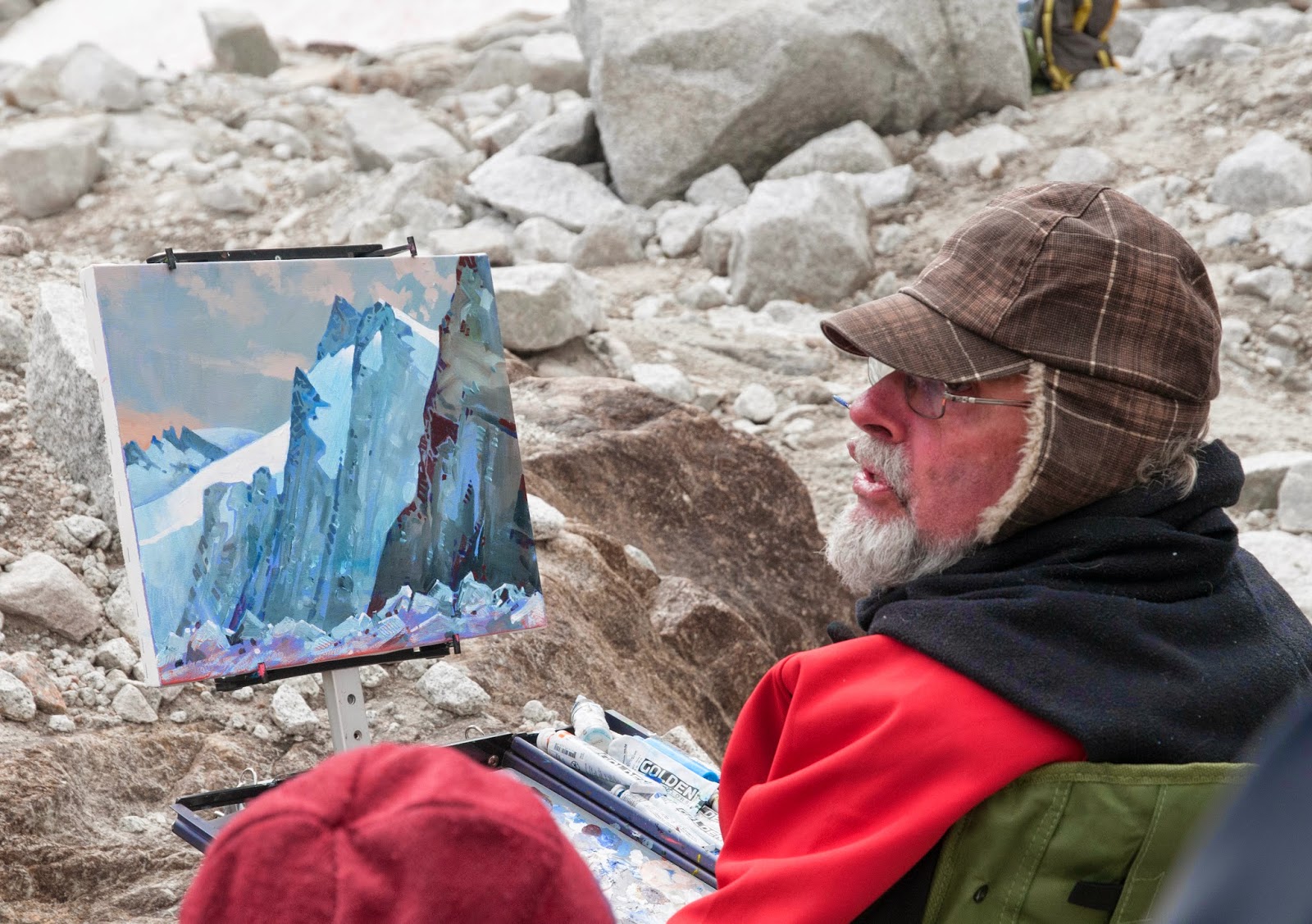 |
| Robert Genn painting in the Bugaboos - August 2013 |
This morning I spent some time resting my hands on two beautiful paintings that were created by my friend and mentor Robert Genn.
I was quietly feeling him in them, sensing how every inch of them held his personality, his expression, his unique way of responding to the world. It was so clear that these paintings are and always will be my direct connection to him, no matter where he is in the Universe.
There are some important truths I learned from Bob in the time he was in my life, and I feel inspired to share them here as a way of honouring and remembering the remarkable being he was.
On Painting
When you are painting a babbling brook - make gurgling, splashing sounds
One day when we were painting together, Bob came over to help me find my way in a plein air piece. I had the rocks nailed but was struggling with the moving water.
As he placed a few brushstrokes on my painting, he mimicked the dancing, playful sound of the water. He was connecting with the ‘creek-ness’ of the creek, bringing it fully into the painting.
Singing helps, too
I remember painting fairly near to him on a plateau at Lake O’Hara one sunny July afternoon when I heard him start singing to himself “For he’s the jolly good fellow...” in a quiet, self-entertaining way.
He was completely immersed in an experience of joyful curiosity, in a state of play and wonder, as he explored what was possible between the world in front of him and the world inside of him.
Stop searching and get started
(A variation of "Go to your room.")
I spent a day painting in a peaceful cove on Gabriola Island with Bob and his constant four-legged companion Dorothy. For the first hour or two, Bob painted while I roamed around with my camera, looking for something that inspired me to paint.
As I returned to where he was painting, Dorothy was anxiously whining about something and I was amused to hear him admonish her. “Dorothy”, he said, “get a hold of yourself.”
He looked up at me from his perch on the beach, surrounded by 4 really good ‘starts’ and a 5th on his easel, and shot me a glance with a wry smile that suggested I also take his advice...
Stop searching, sit, settle. Let the paintings find you.
On Life
Do what feels true for you
Bob wasn’t ruled by what others thought, or ideas about what he ‘should’ do. He did what compelled him, and didn’t do what didn’t. He was an example of how to live an incredibly authentic life.
Stir the pot - It’s where all the good stuff happens
He was bold enough to ask inflammatory questions and declare controversial opinions. Whenever he put out an especially ‘hot’ letter, I could sense him sitting back and rubbing his hands with gleeful anticipation as soon as he hit send, deeply curious to see what polarized, emotionally charged, lively discussions would ensue.
He believed that contrary opinions made for elevated, interesting conversation, and he was always more than happy to stay and participate in the debates he initiated.
Ask others who they are, what they believe, and why
I saw Bob do this with pretty much every person he met. He knew he would learn something new, and it often created friendship. People were a wonder to him, an adventure, an opportunity to lean in for exploration and discovery.
He was genuinely, absolutely fascinated by human nature - both other’s and his own.
Be generous with your wisdom, influence and time
The first conversation I ever had with Robert was when I was starting out with galleries. I quickly found there were many confliciting policies, opinions and expectations, and I wanted clarity about what was fair for both the artist and the gallery. I decided to make a list of all the questions I had, and call up several professional artists to ask their opinions.
I had never met Robert, but I cold called him in his studio, thinking, “What’s the worst that could happen?” He engaged in conversation with me for more than an hour that day, and so began a friendship that lasted over 15 years.
It was an integral part of his nature to share and be of service, to give a leg up, to get behind anyone he saw was invested in themselves, and to help them get where they were headed.
Be in the vibrant drama of life unfolding - instead of ‘creating’ drama around it
Bob met his diagnosis and the hard reality that came with it head on, with absolute simplicity and clarity. His moments from his diagnosis to his death were spent living fully into them - free of spinning a story about them.
He chose to respond instead of reacting. He brought presence, care and attention to his dying, meeting each moment, right to the end, with skillful intention.
I heard a great Virginia Woolf quote today:
“Arrange whatever pieces come your way.”
Bob arranged his last pieces as powerfully as he arranged brush marks on his canvases. He met this experience in the same way he met every one of his paintings. Rather than focusing on ‘what was’ - he was far more interested in exploring “what could be”.
He was, and continues to be, an inspiration and an incredible gift in my life.
Fare well my friend, I wish you continued fascination and curious exploration as you continue on your journey. xo



























